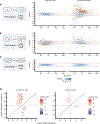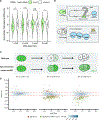Landscape and regulation of mRNA translation in the early C. elegans embryo
- PMID: 40450690
- PMCID: PMC12291612
- DOI: 10.1016/j.celrep.2025.115778
Landscape and regulation of mRNA translation in the early C. elegans embryo
Abstract
Animal embryos rely on regulated translation of maternally deposited mRNAs to drive early development. Using low-input ribosome profiling combined with RNA sequencing on precisely staged embryos, we measure mRNA translation during the first four cell cycles of C. elegans development. We uncover stage-specific patterns of developmentally coordinated translational regulation. Our results confirm that mRNA localization correlates with translational efficiency, though initial translational repression in germline precursors occurs before P-granule association. Our analysis suggests that the RNA-binding protein OMA-1 represses the translation of its target mRNAs in a stage-specific manner while indirectly promoting the translational efficiency of other transcripts. These findings illuminate how post-transcriptional mechanisms shape the embryonic proteome to direct cell differentiation, with implications for understanding similar regulation across species where maternal factors guide early development.
Keywords: C. elegans; CP: Developmental biology; CP: Molecular biology; OMA-1; P granules; Ribo-ITP; cell fate determination; embryogenesis; mRNA translation; maternal transcripts; post-transcriptional control; ribosome profiling; translational regulation.
Copyright © 2025 The Author(s). Published by Elsevier Inc. All rights reserved.
Conflict of interest statement
Declaration of interests The authors declare that they have no competing interests related to this work.
Figures







Update of
-
Landscape and regulation of mRNA translation in the early C. elegans embryo.bioRxiv [Preprint]. 2025 Apr 1:2024.12.13.628416. doi: 10.1101/2024.12.13.628416. bioRxiv. 2025. Update in: Cell Rep. 2025 Jun 24;44(6):115778. doi: 10.1016/j.celrep.2025.115778. PMID: 39829802 Free PMC article. Updated. Preprint.
References
MeSH terms
Substances
Grants and funding
LinkOut - more resources
Full Text Sources
Miscellaneous

